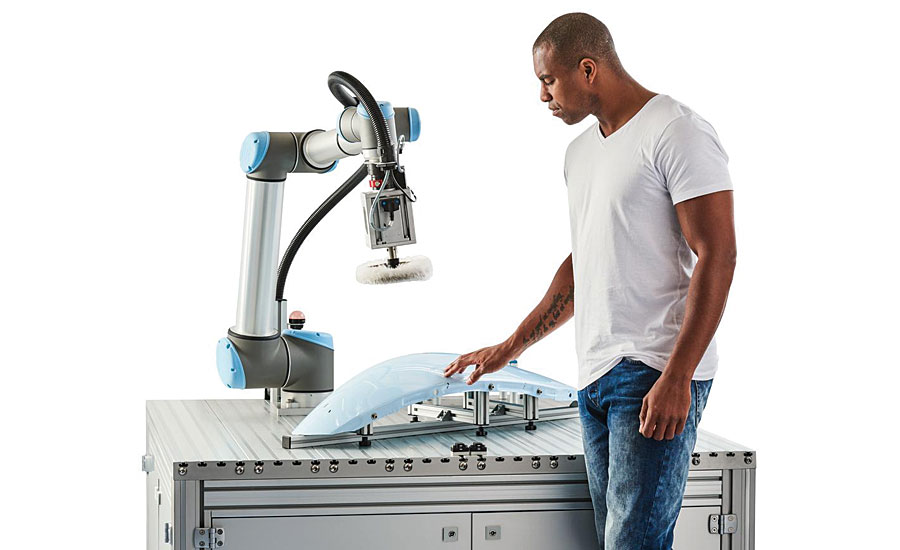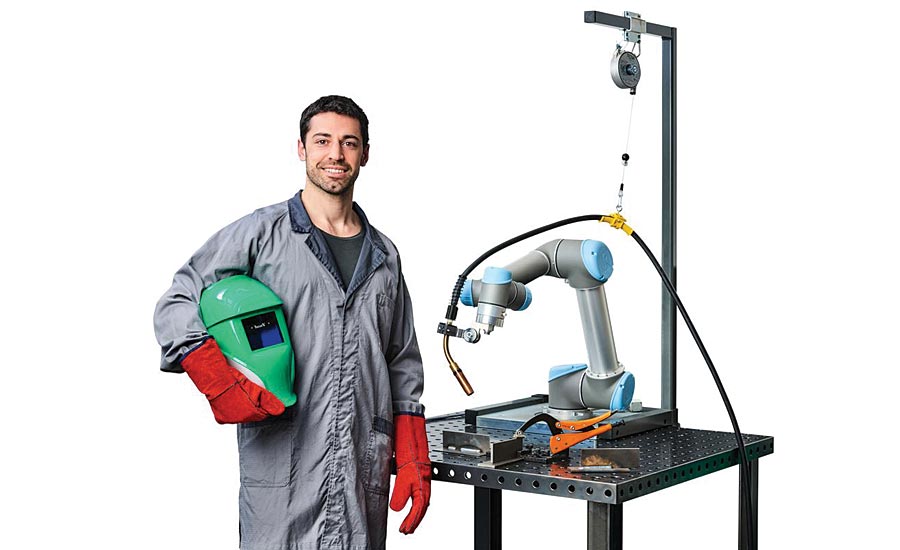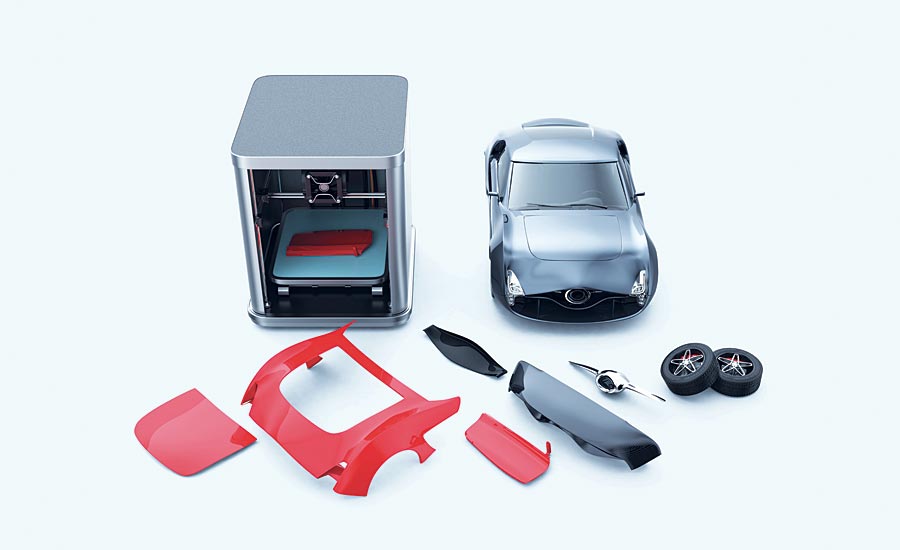At IMTS 2018, like at any industrial trade show, the predominant theme was Industry 4.0. Although Industry 4.0 still has not scaled up to cover a significant percentage of manufacturing setups, its vision of near-total automation—and the promise of resulting cost savings—has clearly captured the industry’s imagination.
More importantly, even though the “lights out” factory is still a rare phenomenon, the connected automation technologies that form the backbone of Industry 4.0 are seeing widespread and growing deployment. These technologies also are making important differences in the manufacture of many types of products and, in industries like healthcare, even in the provision of services.
The role of robots
The use of robots in manufacturing has been on the rise since the 1960s, when they were first introduced as part of what technologists call Industry 3.0, defined by programmable logic and advanced manufacturing. Robots grew up in the car industry, where they were used primarily to weld car bodies together.
As technologies matured, robots began seeing use in other areas such as logistics, and in the medical and food industries. 2006 was the first year more robots were used outside the automotive industry than inside of it.
The main driver behind the rise of industrial robots is said to be a desire to reduce or eliminate the “Three D’s”—dull, dangerous and dirty jobs. But other important drivers include the need for consistency of quality and consistency of flow in manufacturing.
Today, robots are used not just in huge manufacturing and logistics facilities, but in small and medium-sized businesses too, thanks to the advent of smaller, more affordable and easy-to-use collaborative robots.

Far from fenced-off industrial robots that replace human workers with automated processes, collaborative robots enhance human craftsmanship with the speed, accuracy, and precision required to make modern products with a human touch. Source: Universal Robots
The benefits of robotic automation include the following:
- Robots improve the consistency of product quality and production line flow, meeting demand for high-quality products at a lower cost.
- They save workers from having to perform repetitive, tedious, and dangerous tasks at work.
- Today’s connected or “Industry 4.0” robots are able to consistently generate data on parts flow and process quality—data that can be used by AI or old-school data analysis to optimize both a factory and manufacturing processes.
- Thanks to greater inherent flexibility than special machines or other hard automation, robots enable greater product variation on a single line and, when integrated with logistics systems in Industry 4.0 setups, enable factories to produce variants based on the customer’s choice of pre-configured options (often referred to as “mass customization”).
- Because robots cost almost the same everywhere in the world, they can help companies reshore manufacturing jobs that have been transferred to low-cost labor countries and level the playing field in general.
From mass production to mass personalization
Point 4 above—that connected Industry 4.0 technologies, including robots, are enabling manufacturers to mass customize their products like never before—is worth looking at in detail. Let’s take buying a car as an example: Many readers of this article will have grown up under Industry 3.0, which accompanied the rise of computing in business.
Buying a car in the 1970s, ‘80s, and ‘90s usually involved selecting a make and model at a car dealership, and then, if nothing in the showroom quite fit the bill, perhaps ordering a car in a particular color and with certain extras like air conditioning. Granted, this is a
lot of choice compared to what Henry “as long as it’s black” Ford had to offer (i.e., Industry 2.0). But it’s nothing like “configuring” a car online today.
Today, car buyers have so many options to choose from that any given buyer has a good chance of ending up with a car that at least appears to neighbors, co-workers, and so on as one of a kind. Now, if you are the owner of this car, if you live in a city of, say, half a million people, and if nobody else has a car that’s exactly like yours, then you are driving a car that, to all appearances, was designed uniquely for you. Even if you’re not a millionaire. Even if it’s not a particularly expensive car.

Industry 5.0 is a return to what, at least in many respects, resembles a pre-industrial form of goods production, but one that is enabled by the most advanced industrial automation technologies out there. Source: Universal Robots
Driven by a desire to make affordable, high-quality products that at least give the appearance of uniqueness, today’s mass customization is largely enabled by Industry 4.0 technologies, including internet connections between dealership ordering systems, supply chain systems, and even the robots on the car factory floor.
The customer chooses from a growing list of options. This set of choices is configured and packed in just the right order. The truck arrives at the car factory at just the right minute. And the forklifts deliver the parts straight to the assembly line station where the customer’s “unique” car appears.
This is Industry 4.0, and I believe it is the future of at least a large segment of consumer goods manufacturing. But it is not perfect.
For producers, “lights out” manufacturing provides few opportunities for adding value. It’s all about lowering costs while ensuring product differentiation.
For workers, it’s even worse. Those who are employed in Industry 4.0 setups are expected to work like machines, “programmed” by management to perform an exact number of tasks every hour. It is work for robots, performed by humans only until technology advances far enough to replace the humans altogether. And it would not surprise me if a lean analysis of this type of factory were to find that it wastes human problem-solving skills, value-adding human creativity, and the critical and exclusively human ability to deeply understand customers.
Most importantly, the mass customization described above and enabled by Industry 4.0 is not enough. Because consumers want more. They want mass personalization, which can only be achieved when the human touch returns to manufacturing. This is what I call Industry 5.0.

High mix/low volume is part of the fifth industrial revolution that brings smaller, more personalized batches of products to market. Having a flexible production tool such as a cobot will be key in addressing these challenges. Add a welding torch as end-of-arm tooling and you have a welding robot; the next day, you might want to add a camera for quality inspection or a pneumatic suction cup for pick and place—that’s all doable and simple to do using the same cobot arm. Source: Universal Robots
Psychology trumps technology
In the 1960s, as Industry 3.0 was starting to make waves in society, the Canadian media theory guru Marshall McLuhan proclaimed that “the medium is the message,” that new technologies determine changes in patterns of human thought and behavior. Technologists like me might wish that were the case, i.e. that we are the ones who decide how people act. But I don’t believe that McLuhan was right. I believe that human psychology trumps technology and puts it to its own uses.
I believe that people want to stand out, to be seen as unique, and to express themselves through their choices, including their purchases. Now, for the first time since the dawn of the Industrial Age, technologies are available that enable people to express themselves as individuals through personalized products—not just low-tech products, but any product that can send the right signals. And not just products that only the super-rich can afford, but products within reach even for people with modest incomes.
This desire for mass personalization forms the psychological and cultural driver behind Industry 5.0, which involves using technology to return human value-add to manufacturing. Before we examine that in more detail, I should note that the desire for mass personalization also calls another Industry 3.0 assumption into question.
The American futurist Alvin Toffler’s influential 1970s book “Future Shock” saw too many choices as a problem for consumers, who would need to band together into groups in order to deal with choice overload. Yet in place of Toffler’s “shock,” we see consumers reveling in choice, with one person expressing herself by playing music from an infinite number of options online and another spinning vinyl on a Shinola turntable handmade in Detroit.
The mass-personalization and related trends also call some common Industry 4.0 assumptions into question, especially the oft-expressed but wrong-headed claim that robots are “taking over” and “stealing our jobs.” At Universal Robots, we have found that companies who deploy collaborative robots end up employing more people, not fewer, than they did before they went robotic. Instead of replacing workers, the cobots have helped grow these companies’ business. And we expect that, just as with Industry 1.0, Industry 2.0 and Industry 3.0, this latest wave of industrial automation will result in net job growth, not loss.
To be clear, there are huge swaths of product types that nobody wants personalized and that Industry 4.0 setups, with their traditional industrial robots, are perfect for. Nobody wants a personalized drywall anchor, engine block, or lawn-mower blade. If these products can be made at a minimal cost in a lights-out factory, this would benefit everyone.
Industry 5.0 products, on the other hand, empower people to realize the basic human urge to express themselves—even if they have to pay a premium price to do so. Making these products requires what we call the human touch.

Buying a car in the 1970s, ‘80s, and ‘90s usually involved selecting a make and model at a car dealership and perhaps ordering the vehicle in a particular color and with certain extras like air conditioning. Today, car buyers have so many options to choose from that any given buyer has a good chance of ending up with a car that at least appears to be one of a kind. Source: Universal Robots
The return of the human touch
I believe that the personalized products consumers will demand most and pay most for are products that bear the distinctive mark of human care and craftsmanship. Fine watches, craft beers, designer items of every kind, and even (as I saw in the supermarket recently) black salt from Iceland, hand-dyed with local coal.
Products like these can only be made through human involvement, human engagement. And I believe that this human touch, above all, is what consumers seek when they want to express their identity through the products they buy. These consumers accept technology. They don’t mind if automation, for example, is a part of the manufacturing process. But they crave the personal imprint of human designers and craftspeople, who produce something special and unique through their personal effort. This is personalization. This is the feeling of luxury. This is the future.
At Universal Robots, we call this trend “Industry 5.0” mainly as a good-natured jab at Siemens, who was behind the Industry 4.0 moniker. But in a sense, what we’re calling Industry 5.0 is more anti-industrial than industrial. It’s a return to something earlier. To a time before industrialization, when a gift, for example, was something someone you know might have spent months hand-knitting or hand-carving just for you, because the person who made the gift knew you personally and thus knew how to make a gift for you and no one else.
But how do the human designers and craftspeople that today’s consumers look for in their purchases make products that live up to the quality standards people expect today? And that come at a price people can afford? Collaborative robots are a big part of the answer.
Enter collaborative robots
Collaborative robots are exactly the tools companies need to produce the personalized products consumers demand today. Collaborative robots bring the human touch to the masses.
Far from fenced-off industrial robots that replace human workers with automated processes, collaborative robots enhance human craftsmanship with the speed, accuracy, and precision required to make modern products with a human touch. Because while consumers might want to express themselves through market-square baskets and hand-painted flowerpots, they also want to do it with their smartphones, luxury headsets, and “personalized” car designs.
Collaborative robots are essentially power tools that give craftspeople, aka “operators,” superhuman powers in terms of speed and accuracy. And this is what it takes to make industrially manufactured products with a human touch.
Broader implications
As I mentioned earlier, what I’m calling Industry 5.0 is in fact not an incremental development from Industry 4.0. It is not just more ramped-up automation. It is, in an important sense, the end of automation, but an “end” that is, in fact, enabled at least in part by robotic automation. That, in my view, is the great irony in the latest leap forward in automation, whether you call it Industry 5.0 or something entirely different. It is a return to what, at least in many respects, resembles a pre-industrial form of goods production, but one that is enabled by the most advanced industrial automation technologies out there, starting with collaborative robots.
It’s not like me to wax too philosophical. But I might suggest that what I’m referring to as Industry 5.0 in this article addresses, at least in some small way, what Karl Marx called alienation: the idea that, through modern industrial production, workers lose control over their lives by losing control over their work. That they become automatons, who only go through the motions of human labor without contributing to or benefiting from it in any meaningful way. By putting human beings back at the center of industrial production, aided by tools such as collaborative robots, Industry 5.0 not only gives consumers the products they want today, but gives workers jobs that are more meaningful than factory jobs have been in well over a century. Q
